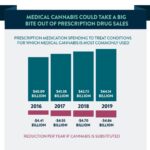A Prescription to Disrupt the Pharmaceutical Industry

Medical Cannabis Could Take a Big Bite Out of Pharmaceutical Sales
May 21, 2017
Medical Cannabis Poised to Cannibalize The Pharmaceutical Industry
May 24, 2017By J.J. McCoy, Senior Managing Editor for New Frontier Data
Despite recent opinions shared by members of the Trump administration, according to “Health Effects of Marijuana”, a report published in January by the National Academies of Science, cannabis and related products have been found effective for treatment of a range of medical conditions. New Frontier Data identified nine conditions in particular to assess the impact of the legalization of cannabis would have on prescription drug use.
Among those, spending on treatments for chronic pain and post-traumatic stress disorder (PTSD) represented about 60% of the total. Overall in 2016, it was estimated that patients spent nearly $14.3 billion and $10.6 billion, respectively, to treat chronic pain and PTSD. The costs to treat sleep disorders, anxiety, epilepsy, nerve pain, chemotherapy-induced nausea and vomiting (CINV), Tourette syndrome, and glaucoma collectively accounted for the other 40% dedicated toward treatments.
There is significant savings to be realized in the health care system both to consumers and the U.S. government. It is estimated that cannabis and related products can replace between $4.4 billion and $4.9 billion of current annual spending on those existing treatments.
To estimate the portion of the U.S. pharmaceutical market that can be replaced by cannabis and related products given national adoption of medical cannabis laws, New Frontier Data performed analysis on the current and projected market sizes of prescription drugs for those nine medical conditions, along with glaucoma and seizures/epilepsy (two other maladies currently treated with cannabis in many states with medical cannabis laws).
Reduced Prescription Medication Use in States with Medicinal Cannabis
According to a Health Affairs study published in July 2016: In states with medical cannabis laws, the use of prescription drugs where cannabis is a recommended replacement has fallen by an average of 11%. The study concluded that there was strong evidence that observed shifts in prescriptions were due to the passage of medical marijuana laws. By applying that decrease to the total amount spent in the U.S. on treatments for such conditions, it is estimated that cannabis and related products can replace prescriptions overall for savings of approximately 17% to 19% by 2019.
Also: Such projected decreases in government spending relate only to spending on pharmaceuticals, and do not incorporate any potential savings from government spending on ambulatory, impatient, or emergency care. Intuitively, if patients react better to cannabis treatments than existing alternatives, decreases should be seen across those three spending categories, too. For example, in 2013, ambulatory, impatient, and emergency care accounted for $23.9 billion in U.S. government spending for anxiety disorders, and $48.27 billion for depression disorders. The potential cost savings from the use of medical cannabis could be significantly greater than just pharmaceutical savings.
Given such potential savings, further research and analysis is clearly warranted, but these early findings suggest that cannabis could play a highly disruptive role in patient use of pharmaceutical drugs in the years to come.

J.J. McCoy
J.J. McCoy is Senior Managing Editor for New Frontier Data. A former staff writer for The Washington Post, he is a career journalist having covered emerging technologies among industries including aviation, satellites, transportation, law enforcement, the Smart Grid and professional sports. He has reported from the White House, the U.S. Senate, three continents and counting.




